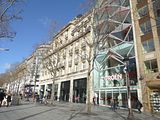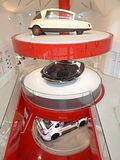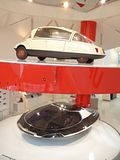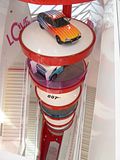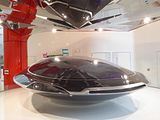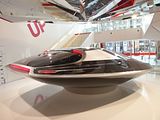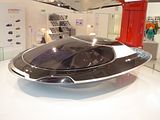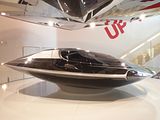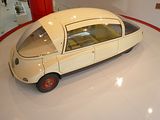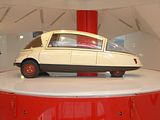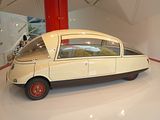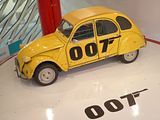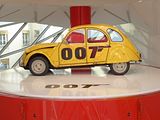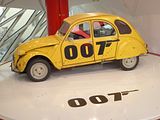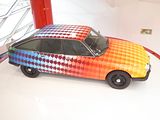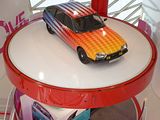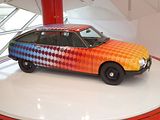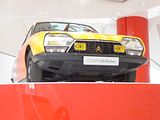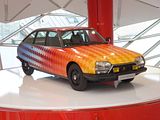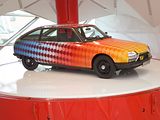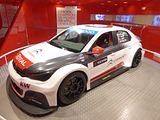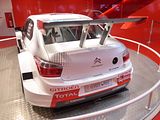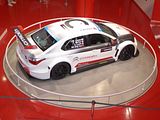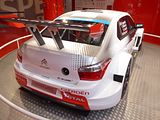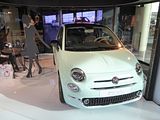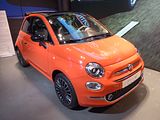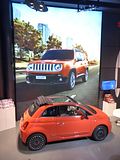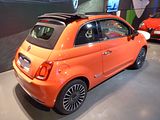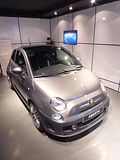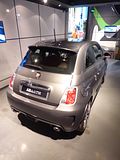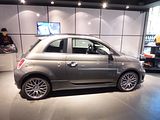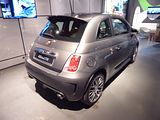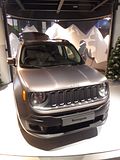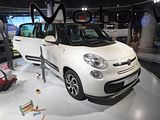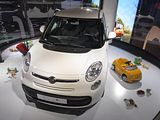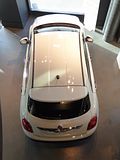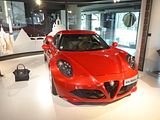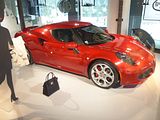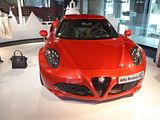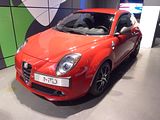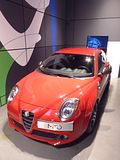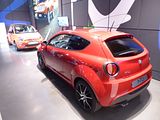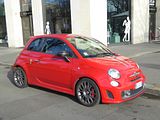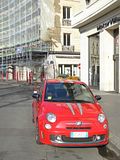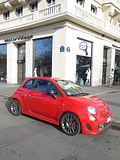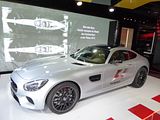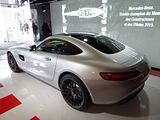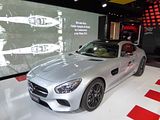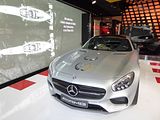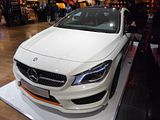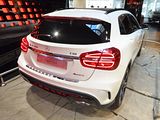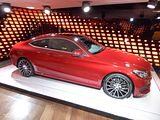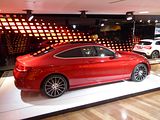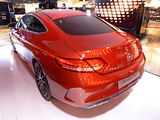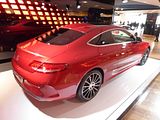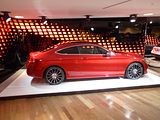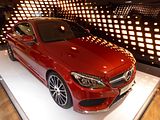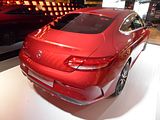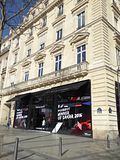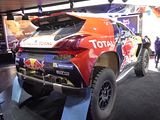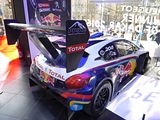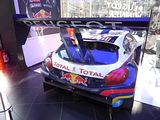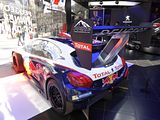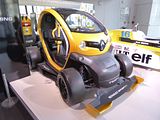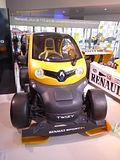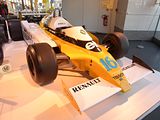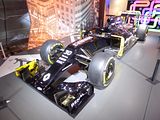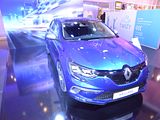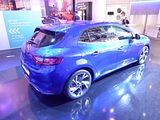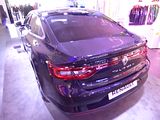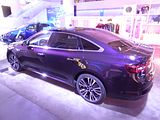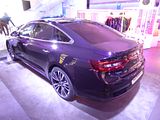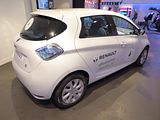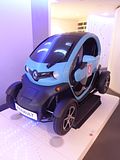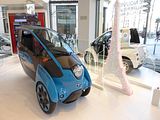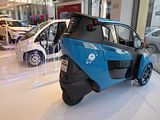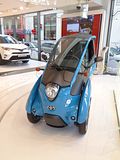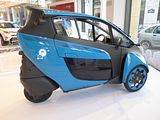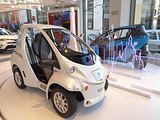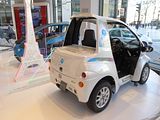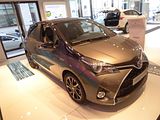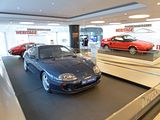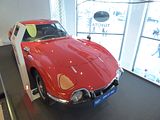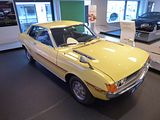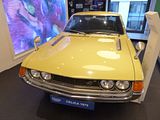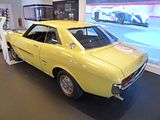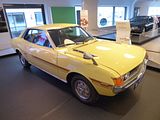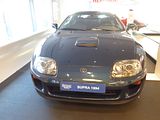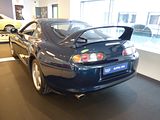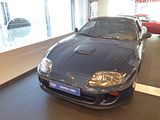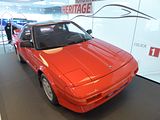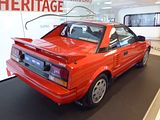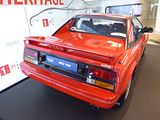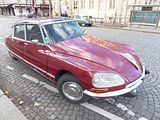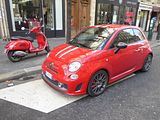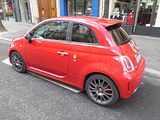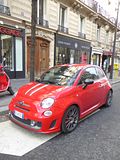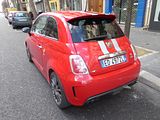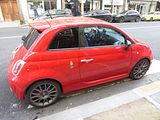The reason for this trip to Paris- not that a reason is really required when as appealing a city as Paris is concerned – was to go to the Rétromobile show, a report on which will be posted separately. That takes one whole day. Which leaves the best part of another day before boarding the flight back to the UK on Sunday evening. As the weekend approached, I was delighted to see that just as in the UK, the weather forecast kept changing, and that the outlook was improving, with suggestions that the Sunday would be a cold but very sunny winter’s day. It seemed that this would make it perfect for wandering out the centre of the city, reacquainting myself with some of the notable landmarks, and although it was initially quite cloudy at Orly Airport, where I was staying, as the train got nearer to the centre, I could see that the sky was indeed blue and devoid of cloud. That did not last all day, but whilst the UK was being drenched and lashed by the gales of the latest named Storm, I was able to wander about the city in full tourist mode. Needless to say, I made sure to allocate some time to the Champs-Élysées area and the car showrooms which are all open on a Sunday, and which prove to be a popular tourist (and locals) attraction. As ever, there was plenty to see and visiting the five of them which feature in this report took me all morning. Here’s what was on show.
CITROEN
I was a little surprised to find that the display here was the same as the one which I saw when last here at the very end of September 2015. Granted that the display was newly set up at that time, but I had rather assumed it would have moved on again, but no, it was as before. The last time I saw the display in the evening, so with artificial light, whereas on this occasion, it was mid morning on a bright and sunny day. It is worth noting that of the various showrooms featured in this report, the C_42 building opens earlier than the others on a Sunday, at 10am. The showroom is right outside the entrance to the Franklin Roosevelt métro station, and even the outside is striking. I’ve remarked on this before, but this time finally managed to get a couple of photos to illustrate the point. Designed by Parisian architect Manuelle Gautrand, it was constructed between 2002 and 2007 as a new flagship showroom, according to a concept “intended to magnify the displayed cars in a building with strong symbolic presence”. The result, as well as housing a shop for branded goods is a kind of corporate totem composed of eight vehicles stacked on platter one on top of the other. The arrangement forms a gigantic upright display around which visitors move in an ascending/descending spiral movement via flights of stairs and landings. From the top, there are superb views up and down the Champs-Élysées, over the city and across the nearby gardens and river. The cars are displayed on revolving circular platforms under a faceted mirror-ceiling that fragments and multiplies their lines and details. Besides enhancing the presence of the display models, we are told that the “effect accentuates the vertical reality of space and creates an exhilarating sense of lightness”. Around this there is faceted glass which, so we are further told, plays on the distinctive shape of the Citroën logo: the chevron. At street level on the Champs-Elysées, the façade begins as a simple flat curtain wall. The double chevron soon appears, proliferating as it rises in free and inventive array right up to the summit. The glass front unfolds a gigantic origami, coloured by diaphanous white and red film that lets subdued clear light into the interior. Enough of the PR speak around the building, what of the cars?
Theme for the current display in the Citroen C42 building is, in Citroen’s own words: “CITROËN [RE]MIX!, an intriguing assortment of cars and concepts, past and present! For an even more vibrant experience, visitors can mix the C_42 venue lighting themselves, using the Light Mix feature. What a way to brighten up the autumn!” Passing the security check that is a feature of all Paris shops, offices and public buildings at present, I cast eyes once more on what has to be of the most intriguing, if not downright bizarre concept cars of recent times, if not ever. Looking like something that was created for a particularly zany sci-fi film, this “car” was created in 2010. Look closely, and it does have a front and a back, and there are head- and tail-lights on it, though practicality would indeed seem to be some way off its design criteria. There was very little information about it at the venue, but after my last visit, I resorted to the trusty Google to find out more, necessary as I do not recall seeing this “UFO” when it was first conceived. It was the work of a French designer, Ora-ito, and it does indeed officially resemble the shape of an UFO, which apparently is supposed to be something of a “mutated” version of the Citroen DS. Shaped like a flying saucer, it does have a particularly aerodynamic body. The concept was supposed to indicate what form transport might take in the future, and the design of the UFO concept car was a combination of science, art & engineering. There are no wheels attached to it, so how it would actually move is less than clear. Its creator claimed that the UFO was not designed as just another concept car but instead it was supposed to convey a universal message to the car industry about the future of transportation through the eyes of an artist.
Up a floor from that bizarre UFO was another rather unusually styled car. Unlike the UFO, I’ve seen this prototype before, as it was shown at Rétromobile in 2014, and it also made an appearance in the UK at the Classic Car Show at the NEC back in 2009. One of a series of concepts created by Citroën from 1955 to 1956 under the direction of André Lefèbvre, the idea behind this one was to produce a water drop-shaped, very lightweight vehicle, which would be more modern and smaller than the 2CV. The overall look of the vehicle was quite similar to the Messerschmitt bubble car. It was equipped with the same 425 cc engine as the 2CV. The vehicle was also nicknamed Citroën Coccinelle (Ladybird in French).
A much better known car from the Citroen Conservatoire was this 2CV, complete with bullet holes. This little Citroen was a star of the silver screen, one of the three 2 CVs used in the 1981 James Bond film “For Your Eyes Only”. It carried Roger Moore and Carole Bouquet and also appeared on the film poster! As is often the case with cars used in the movies, all is not quite what it would seem, as the cars that were used in action shots had a Citroen GS engine squeezed under the bonnet to give them a little more oomph than the standard car.
I had not seen this car before, a Citroen GS “aux Flèches” (ie Arrows, in English). An Art Car, this is a GS revisited by the artist Jean-Pierre Lihou in 1976. The tangy colours, all 73 shades of them, and winding arrows, are said to materialise the Energetism concept developed by this visionary artist. They were applied by hand, taking 40 litres of paint.
Production cars in the display included the latest C4 Grand Picasso and then a couple of floors up from this, although the signage led me to hope I would find the Cactus-M concept, there was instead a production C4 Cactus a large part of which was enclosed in a box.
In the basement there was a reminder of Citroen’s exploits in motor sport. Last time I was here, I did not have the time to go down and inspect from close quarters, simply grabbing a couple of pictures from up above, and I mistakenly attributed it to being the firm’s current entrant in the World Rally Championship, the C4 Élysée WRC car. I was wrong (and have gone and corrected the last report accordingly), as the car shown is actually the World Touring Car Championship model, the TC1. Citroen have entries in both, and although the cars are similar, they are clearly not the same as each is optimised for the demands of its particular type of motorsport, and there are a different team of 6 driving each of the championships. Brit Kris Meeke is one of the key drivers in the WRC, whereas the best known of the Touring Car drivers is Sébastien Loeb who joined the team when it was set up in 2013. Other drivers in 2015 were José María López, Yvan Muller and Ma Qing Hua. Citroen have announced that 2016 will be their last season in the sport, and they will only be running 2 cars, for Yvan Muller and José María López during the forthcoming year. The TC1 has been very successful In 2014, Citroën won fourteen out the first fifteen races and seventeen races out of the total of twenty three in the year , in spite of the inversion of the qualifications grid for the race two and in spite of the 60 kg compensation weight that the Citroën C-Elysée had to carry, as the most competitive car of the championship. This performance brought the team the Manufacturer’s WTCC Championship, 5 races before the end of the season, after the 2014 Shanghai first race, where Citroën recorded a magnificent one-two-three-four. The Citroën World Touring Car Team pilots also got the three first ranks of the Drivers’ World Touring Car Championship. The team – or rather teams, as there was a Sébastien Loeb team, as well as the Citroen/Total one, were equally dominant in 2015, wining both the Manufacturers and the Yvan Muller the driver’s championships.
FIAT CHRYSLER AUTO
This was the second showroom I reached, arriving outside just as the doors were being unlocked at 11am. The overall floor area of this building, labelled as the Motor Village, is small, with space for only a trio of cars on the ground floor, along with a small cafe which spills out onto the pavement. More cars are shown in the basement, and there is one display case on a mezzanine floor, which leads up to a first floor restaurant. Fiat change the displays here quite regularly, so there was something new to see.
Theme for the display that will run from the 20th January to the 3rd March is “Drive me, Lady”. A number of the cars on show were accompanied by props and other display material reflecting a different female person, for a bit of fun.
On the ground floor was the recently facelifted Fiat 500, which the display said would be the car of your “Copine”, or mate.
It was not the only example of the facelifted 500, with a limited edition tin top also on the ground floor and a 500C in the basement. The basement car was a 500C in a new salmon pink colour called Glam Coral, which, judging by the number you see on the roads, is proving quite popular. Whilst I like the new uConnect touch-sensitive infotainment screen, I am less convinced by the styling changes. The body colour insets on the rear lights work with some colours but not others.
There was also an example of the Abarth 595 on show. All Abarths are now rebranded 595 (or 695 for the super potent ones), even the base models like this Record Grey car, with the range having a progression from the 140 bhp entry level car through the 160 bhp Turismo and 180 Competizione to the top of the range 190 bhp 695 Biposto.
Also in the basement of the showroom was the vehicle for the Sports Lady, a Jeep Renegade. The first Jeep not made in America, this car has helped to grow Jeep sales significantly, especially in Europe.
The 500L, not surprisingly, was presented as the car for Mother, with some of the paraphenalia that a family accumulates in the display around it.
By common consent, a little less awkward looking 500X
Slightly surprisingly, perhaps, the Alfa 4C was signed as the car for the Business Woman. For sure, given its price, you would need someone with a decent income to be able to afford one, but as business person’s car, it is not really the most obvious choice!
Final car on display here was an Alfa MiTo, seen in top spec Qv form.
Parked up outside the Motor Village, when I emerged, was an Abarth 695 Tributo Ferrari. It was on Italian plates, and was one of the red cars. More of these were produced than the other colours (Yellow and Abu Dhabi Blue) but they have become very rare in the UK as many of the handful that were initially sold have been exported to other right hand drive markets in Asia. My guess is that in time, some will come back to the UK, but these exclusive (and expensive, when new) cars are not ones you see even at Italian Car gatherings very often.
MERCEDES-BENZ
The Mercedes showroom is long and thin and generally has space for around 5 cars, so picking them from the vast range that the firm offers must be difficult. Fronts piece was an AMG GT, the well-received Coupe that rivals Porsche’s 911, that was launched around a year ago. As a crowd puller, to get people to come and have a look at what else was on display, it was certainly doing its job. Behind the display car was a reminder that Mercedes achieved the double of Driver and Manufacturer’s titles in the 2015 Formula 1 World Championship.
Down the other side of the showroom were three recent additions to the range, a CLA Shooting Brake, a GLA and the new C Class Coupe. None of these appeal to me. At all. The orange rims on the CLA say it all about how Mercedes has moved from its long held position of as a maker of beautifully engineered but rather conservative looking cars to one where bling and froth is all. The CLA was widely regarded as one of the most disappointing cars of the year when it was first launched, with rough diesel engines, and truly awful rear seat access and limited space once installed. The Shooting Brake version does little to ease access, surprisingly, and the steeply sloped rear end means that it is not really much of an estate car load carrier, either. I can think of plenty of better ways of spending £30k on a car of this size.
Sadly. that is true of the GLA, as well. Never going to win prizes for its beauty, this comes across as a niche that Mercedes knew they had to fill with a sort bloated and raised ride-height A Class, and that’s about as good as the car is.
The C Class Coupe misses the mark for me, too. It is the rear end styling which is just bulbous. Whilst the same proportions and cues on the larger S Class Coupe may work (that one goes wrong at the front!), here the droopy tail over-emphasises the not inconsiderable width of the car. It is a problem that the latest BMW 4 Series has to an extent, too. Such a shame, as previous generations of both models were elegant, as Coupes should be,. but not this one, to my eyes.
At the very back was an example of the revised A Class, and frankly, that’s the best place for it. Having thrown away the USP of the amazing packaging of previous A Class models, we now have a “me too” premium hatch which whilst decent enough, is nowhere near top of a very competitive class.
PEUGEOT
The Peugeot showroom is the one nearest to the Arc de Triomphe, so this was the one I walked past first, at just gone 10am, which is when I realised that I was going to have wait a few more minutes before gaining access anywhere. I could, however, see the signage in the window reminding us all that this is the marque which won the Dakar Rally again in 2016.
Sure enough, later in the morning, when I had meandered back to this showroom, I was able to have a look at the winning car, from close up, as it was the centrepiece of the displays in what is a smaller footprint than those enjoyed by the other brands. A joint venture between Peugeot, Red Bull and Total, the Peugeot 2008 DKR shares an unmistakable family resemblance with Peugeot’s road-going crossover, albeit with more muscular forms and more imposing overall proportions that have been honed to meet the challenges of one of the worlds toughest events, in which Carlos Sainz and Cyril Despres were to compete. The 2008 DKR features an aggressive stance dictated by the technical constraints associated with its mission. There was a very precise brief for Peugeot’s Style Centre, with the basic key dimensions, as well as other information such as the cabin space required, plus the wheel size and the suspension travel. There was also aerodynamic data resulting from early simulation work. One question that Peugeot Sport’s design team had to answer at a very early stage concerned the new beast’s transmission: four-wheel or two-wheel drive? The decision effectively influenced the car’s design in two key areas: Having carried out an in-depth analysis of what already existed in the world of cross-country rallying and weighed up the benefits of the different solutions, Peugeot opted for an approach that was quite different to that of the competition. Given the off-road capability of two-wheel drive transmission and its ability to run on sand, that was the choice. It enabled the fitment of bigger wheels and allowed more suspension travel. The 2008 DKR consequently sits on 37-inch diameter Michelin tyres. A further bold choice as to use a diesel engine, making this car unlike its main rivals. The decision to go for a two wheel drive solution has another advantage: far less weight, as allowed by the regulations. The bigger wheels provide a certain advantage when it comes to coping with the many pitfalls associated with the type of terrain that will be encountered, and it is possible to minimise the front overhang. The 2008 DKR can practically climb vertical walls! And that’s not all! Longer suspension travel – 460mm instead of 250mm – enhances its ability over dunes and when soaking up uneven ground, a key asset on an event like the Dakar! Another advantage of the larger wheel size is a system that enables the tyre pressures to be adjusted remotely from inside the cockpit upon entering a zone of dunes – a tactic that could yield a gain of precious minutes! In order to exploit these benefits fully, Peugeot Sport’s engineers put their creativity to the test to come up with an extremely compact car. With its 340bhp, V6 twin-turbo diesel mid-rear engine, the 2008 DKR resembles a muscular feline ready to pounce and soak up obstacles. Fitting all of the vital assemblies into such a small space gave the designers quite a headache, but as small cars tend to perform more comfortably over twisty WRC-type stages, this arrangement increased the potential of two-wheel drive cars in situations where the 4x4s tend to have the edge. The car went on to win the event.
Equally wild looking was the 208 Pikes Peak car, in which Sebastien Loeb, on his first “Race to the Clouds”, shattered the record with an astonishing time of just 8 minutes 13.878 seconds.
At the back of the small showroom was the 908. Developed by Peugeot Sport in 2011 for the Le Mans Prototype category of racing, and powered by a diesel engine, it was the successor to the Peugeot 908 HDi FAP which had competed since 2007. The newer 908 featured a smaller diesel than its predecessor, using a 3,700 cc HDi V8 engine with Honeywell Turbo Technologies turbocharger in order to meet new regulations for 2011. The 908 competed in all rounds of the 2011 Intercontinental Le Mans Cup including the 2011 24 Hours of Le Mans. The new 908 lost about 150 bhp compared to 2010 but improvements in the chassis and handling made the car much more agile. Rear tyres are now fitted on the front. The only part that has been reused from its predecessor was the windscreen wiper. The 908’s first competitive outing was at the 2011 Sebring 12 Hours. The new cars faced competition from the older Audi R15+ and the old Oreca 908 HDi FAP. Both Peugeots ran at the front, building a 2-second gap per lap over the Audi but relentless safety car periods cut their lead over time. Marc Gene then shoved the car to the inside of Capello in turn 17. Both cars spun but only Gene hit the barrier and suffered a suspension failure. The #8 led for a while until a slow pit stop and a spin by Lamy threw them back to third. The Peugeots finished 3rd and 8th. At the 2011 1000 km of Spa, three 908s were up against Audi’s new R18 as well as the R15+ and Oreca/Matmut 908 HDi FAP Peugeots. After a disastrous qualifying session leaving only one 908 in the top ten, they quickly got to the front of the field during the first laps, and soon were running 1-2-3 after the R18s were running into technical issues. After an off by the third placed 908 piloted by Pedro Lamy, Tom Kristensen’s R18 took its position. Following damage to the engine cover of the R18, the Peugeots regained the podium positions, but a front suspension failure half an hour before the end of the race led to a nine-minute pit-stop and a drop into position eight. Nonetheless this same car achieved the fastest lap of the event at 2:03.699. At Le Mans the three Peugeot 908s were able to battle Audi for the lead of the race. Aided by fewer pit stops Peugeot remained on the same lap as the lead Audi, but failed to catch the leader in the final hour, the No. 9 Peugeot crossing the finish line thirteen seconds behind the race winner. A hybrid version of the 908 known as the Peugeot 908 Hybrid4 was expected to run in the FIA World Endurance Championship in 2012 in addition to an updated version of the regular car, but after poor economic performance in 2011 Peugeot cancelled their race program for 2012. Peugeot was already at Sebring to test the new cars, so the announcement came as a severe blow to Peugeot Sport Total.
Sole road car in the showroom was an example of the new 308 GTi, a sporting hatch that is intended to rival the Golf GTi, Leon Cupra and Focus ST. That little steering wheel mounted too low and so that – fr my driving position at least – it obscures the instruments would be an absolute deal breaker, I don’t care what Peugeot say to the contrary. Other than that., the car is well finished and by all accounts quite decent to drive.
RENAULT
Theme at Atelier Renault at present is “Passion for Life”. There seemed to be two different facets to this. In the middle of the ground floor display area (upstairs is a rather good bistro), were some of the latest production models, and at the front and very back of the showroom were cars to mark Renault’s re-entry into Formula 1 motor racing for the 2016 season.
Starring on the display turntable in the main window was a famous Formula 1 car driven by a man who was not just a legend in his native land, but also respected the world over. This was Alain Prost’s RE30, a designed by Michel Tétu and Gérard Larrousse for use by the Renault team in the 1981 Formula One season. The RE30 was an entirely different design from its predecessor, the RE20. It incorporated carbon fibre into parts of its construction, a material which was becoming more and more commonplace in F1 at the time. The turbocharged engine was developed further and produced around 540 bhp, with twin KKK turbochargers. Renault was joined by Ferrari in developing turbo engines for their cars, with the Ferrari 126 C. The car had advanced ground effect technology, with concessions given to the new rules which banned sliding skirts. The car made its debut at the Monaco Grand Prix in 1981, with Renault using a B-spec. RE20 for the first 5 races in the Americas, Belgium and Imola; Renault did not compete at what was supposed to be the first round at Kyalami in Johannesburg, South Africa. Renault replaced Jean-Pierre Jabouille with promising young Alain Prost to partner René Arnoux for the season. After a slow start to the year, in which Prost gained only one podium finish, he broke his duck with a home win at the French Grand Prix at Dijon in changeable weather, and followed up with wins at the Dutch Grand Prix at Zandvoort and the Italian Grand Prix at Monza, which gave him an outside chance at the world championship. Unreliability cost him his chance, but he finished a respectable fourth in the final standings. Arnoux had a very unlucky season and bore the brunt of most of the mechanical trouble that affected the RE30’s development, most of which was done by Prost. The RE30 didn’t suit Arnoux’s aggressive, over-steering driving style as opposed to Prost’s smooth, under-steering driving style which may have caused some of the problems with Arnoux’s performance that year.
1982 For 1982, the car was updated and modified with a redesigned nose section, new rear wing and kick-ups added in front of the rear wheels. The engine was further developed to give around 590 bhp. Prost made a strong start to the season and won in Brazil and South Africa to underline his intention to win the championship that season. However, those would be his only victories of the year, as Ferrari, Williams and McLaren overtook Renault in the technology race. The RE30B was a formidable qualifying car, with Prost or Arnoux on pole for the majority of the races, but reliability was suspect for both drivers, mostly due to problems with the new and rather experimental electronic fuel injection which failed repeatedly during the races proper. It was a shame, because the RE30B was probably the most competitive car that year, having the best compromise on outright performance- with a good chassis and aerodynamics, and a powerful enough engine. The car was quick around all kinds of different circuits- even around even tight, slow circuits like Monaco, Detroit, Zolder and Long Beach; circuits where the other cars with turbo-charged engines (Ferrari, Brabham-BMW, and less competitively Toleman-Hart) lacked in performance thanks to massive turbo lag, so the cars with the less powerful naturally aspirated engines were able to capitalize by being able to get more power more quickly out of slow corners. Arnoux took two wins during the latter half of the year, but only finished four races during the whole season. Prost was in sight of victory at Monaco, Austria and Dijon but had problems during the final laps of all three races. He eventually salvaged fourth in the championship, whilst Renault finished third in the constructors’ championship. The RE30 was further updated to “C” specification for the early races of the 1983 season, until the new RE40 was available. Eddie Cheever drove the RE30C for 2 races and team leader Prost drove the RE30C for one race. With seven wins and sixteen pole positions, the RE30 was Renault’s most successful car until Fernando Alonso’s world championships of 2005 and 2006.
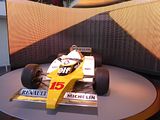
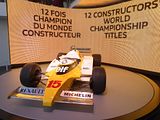
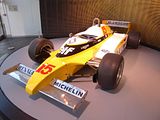
Opposite the RE30 was something very different, the Twizy F1
At the very back of the showroom was the latest Renault Formula 1 car, the RS 16, in is new black livery, marking the return as a full works team. Kevin Magnussen, who replaces the outgoing Pastor Maldonado, will race alongside Jolyon Palmer at the rebranded Renault Sport F1 Team, with GP3 racewinner Esteban Ocon joining as third and reserve driver. The new car, which was manufactured at the team’s Enstone base, features a predominantly black livery, though Renault Sport chief Jerome Stoll hinted at the unveiling of the car that the colour scheme could change ahead of the 2016 season opener in Australia. The car will be powered by Renault’s R.E.16 power unit, which will continue to be developed in Viry-Chatillon. Alongside Magnussen and Ocon, Renault also confirmed that Bob Bell will return to Enstone as chief technical officer, with Nick Chester becoming the chassis technical director and Remi Taffin the engine technical director. Renault are serious in their plans, hoping to recreate some of the past glories and add to the 12 World Titles that we are reminded about in the display over the RE30 at the front of the showroom. Can they do it? We don’t have long to wait before we start to find out.
In the middle of the display area were three new models, none of which are yet to be seen on British roads, and only one of which be sold here anyway. That car is the fourth generation Megane. When I visited in September, there was an example of the car on show, but it was locked. This time, the car displayed, a 5 door GT, was open for inspection. The inside is nicely done, looking more of a quality offering than its smaller brothers, Clio and Captur, with plenty of soft touch plastics and a cohesive design to the dash and console. There is a large high resolution display screen in the middle of the dash which is properly integrated, again unlike the Clio. Outside, the car is neat, if a little bland. French market sales have not started yet, but are imminent, with the car featuring in comparison tests in many of the French motoring magazines (which it did not win, the journalists preferring the Peugeot 308), and we in the UK will see the car around the middle of the year.
We won’t see the Talisman at all. Replacement for the Laguna, Renault have opted for a traditional three box design for their new D-segment car. The combination of the colour of this model and the lighting, as well as the fact that there were lots of people who wanted to look at it and get in made the photographer’s job difficult here. I have to say that I think in trying to come up with something uncontroversial, Renault have also produced something really rather anonymous. The interior is very similar to that of the Megane, but with more equipment and more space. The French will no doubt buy it in reasonable quantity, but the decision not to import it to badge-snobbery UK is probably sensible.
In the same photographically difficult colour was the latest Espace, a car which has been on sale for a little while, but I don’t recall seeing a single example out on the roads during this visit or my last one. In moving the car away from its People Carrier roots to something that is a bit more SUV like, Renault would seem to have deprived the model of the feeling of spaciousness which was the hallmark of previous generations of the car.
Tucked away in the corners were two of Renault’s ZE (Zero Emission) cars, the Zoe and the Twizy.
TOYOTA
There were two contrasting themes in the Toyota showroom. Downstairs concentrated on machines using Hybrid technology, whilst upstairs it was Toyota sportscars that filled the floor space.
On show on a plinth right by the door was Toyota’s successful Endurance racer, the TS030, which won just about everything apart from le Mans. The TS030 marked Toyota’s first works entry at the 24 Hours of Le Mans since the Toyota GT-One was entered in the 1999 race, and is notable for being the first petrol-powered hybrid car to be entered in the FIA World Endurance Championship. The TE030 features the Kinetic Energy Recovery System (KERS) regenerative braking device to charge a supercapacitor. The extra power is directed to the rear wheels. Under the 2012 Le Mans rules they were allowed to use the system at any speed, unlike Audi who had elected to send power to the front, with a restriction to a minimum speed of 120 km/h. Expected to make its debut at the 6 Heures de Spa-Francorchamps in May 2012, a testing crash at Paul Ricard had damaged the chassis beyond repair, so the team was forced to delay the TS030’s debut until that 24 Hours of Le Mans in June because of the time needed to produce a new monocoque. On lap 82 at Le Mans, Anthony Davidson’s TS030 became airborne after a collision with Piergiuseppe Perazzini’s Ferrari, and collided hard with track barriers. Davidson suffered two broken vertebrae from the incident. The second TS030, which had briefly led the race before the accident, retired several hours later after an engine failure. After finishing in second place at the 6 Hours of Silverstone, the TS030 Hybrid took its first pole position and victory at the 6 Hours of São Paulo race, held at the Autódromo José Carlos Pace in São Paulo, Brazil. It finished the 2012 season with two more victories at the 6 Hours of Fuji and the 6 Hours of Shanghai. Toyota started the 2013 schedule with two 2012 spec TS030’s. Both showed stunning pace in qualifying at the first race of the season, the 6 hours of Silverstone, with the #7 machine qualifying more than 3 seconds ahead of the nearest Audi, whilst the #8 sister car qualified second. The race however was at best uneventful, with neither car being able to match either Audi’s pace, finishing third and fourth overall having struggled in the first few hours of the race with tyre management. The second round at Spa-Francorchamps would see Toyota debut the new 2013 specification TS030 featuring a revised aerodynamic package and including an updated monocoque. After a close qualifying session, the updated #7 ran near the front of the race for the first three hours, before retiring due to overheating brakes as a result of a malfunctioning energy recovery system. With the rear brake assembly designed to be assisted with certain amounts of mechanical retardation provided by the hybrid recovery system by design, it did not provide the deceleration when malfunctioning, thus overloading the conventional rear brakes. The sister car remained in fourth for the rest of the event, closing what was a mixed outcome for the team. Post race, technical director Pascal Vasselon complained that his team’s analysis from Spa showed that the current Balance of Performance significantly favoured Audi’s turbodiesel powerplant over its own normally-aspirated petrol engine, calling the ACO and FIA for a more favourable balance of performance to be applied before Le Mans. As agreed at the start of the season, the FIA and the ACO reviewed the technical regulations at the end of May 2013 to adjust the performance between petrol and diesel LMP1 cars for the remainder of the 2013 WEC Championship. From the 24 Hours of Le Mans onwards, petrol-engined cars were permitted an additional 3 litres of fuel capacity. It was not enough to give the Toyota victory, though, with Audi once again claiming the chequered flag.
Rotating on a turntable in the front window were two cars which could hardly be more different. These are Toyota’s view of the future of city cars and personal transportation, the i-Road and the COMS. Having shown the i-Road at a number of Shows in recent years, Toyota has now put the concept out on the streets and a pilot project is currently underway in Grenoble to gain experience from using this vehicle which is something of a cross between a car and a motorbike in real life conditions. The Toyota COMS ultra-compact electric vehicle, looking a bit like a glorified Golf Buggy, was first shown in 2012. It has a price of around 798,000 yen, or around $10,000 US and is available in two options – P for consumers and B for delivery. This diminutive device can achieve a maximum speed of around 38 miles per hour and it has a range around 31 miles. Weighing around 881 pounds, the COMS is powered by an electric motor with a rated output of 0.59W. It is equipped with regenerative braking, which helps to restore power to the vehicle’s battery. Recharging time via a standard Japanese 100 volt home outlet is around six hours, and Toyota estimates it costs about $1.50 for a full charge.
Also on display were Hybrid versions of three more familiar Toyota models: the made in France Yaris, a Plug-In Hybrid version of the Prius and the new Hybrid version of the facelifted RAV4.
Upstairs there was a special display of 4 sports cars from Toyota’s Heritage. All four were sourced from the Loumann Museum in the Netherlands, and they made for an interesting collection.
Oldest of them, and my personal favourite, was the 1969 Toyota 2000GT. Sadly the combination of where this one was positioned and the lighting made photography very difficult, so there are not the raft of pictures that I would otherwise willingly have taken, as you do not see these cars very often. A front-engine, rear-wheel drive, two-seat, hardtop coupé grand tourer designed by Toyota in collaboration with Yamaha, the 2000GT was first displayed to the public at the Tokyo Motor Show in 1965. It was then manufactured under contract by Yamaha between 1967 and 1970. In Japan, it was exclusive to Toyota’s Japanese retail sales channel called Toyota Store. The 2000GT revolutionised the automotive world’s view of Japan, then viewed as a producer of imitative and stodgily practical vehicles. As sleek, high-performance fastback, it demonstrated its auto makers could produce a sports car to rival the better marques of Europe. Most of the 2000GT’s design was done by Yamaha, which also did much automobile work for other Japanese manufacturers, originally for Nissan rather than Toyota. Many credit the German-American designer Albrecht Goertz, a protégé of Raymond Loewy who had previously worked with Nissan to create the Silvia, as inspiration. He had gone to work for Yamaha in Japan in the early 1960s to modernise Nissan’s two-seater Fairlady sports car. A prototype 2000GT was built, but Nissan declined. Yamaha then proposed the design to Toyota, whom they also did contract work for, then perceived as the most conservative of the Japanese car manufacturers. Wishing to improve their image, Toyota accepted the proposal, but employed a design from their own designer Satoru Noza. The resulting car is widely considered a classic among 1960s gran turismos. Its smoothly flowing “coke bottle” bodywork was executed in aluminium and featured pop-up headlights above large plexiglass covered driving lamps flanking the grille similar to those on the Toyota Sports 800. Bumpers were minimal, and the car was extremely low, just 45.7 in to the highest point of the roof. In spite of a custom open-top version built for the James Bond film You Only Live Twice, a factory-produced convertible was never offered. The engine was a longitudinally mounted 2.0 litre straight-6, based on the engine in the top-of-the-line Toyota Crown sedan. It was transformed by Yamaha with a new double overhead camshaft head into a 150 hp sports car unit, with three carburettors. A five speed manual gearbox was part of the spec. Just 351 examples were made, and on the rare occasions that one comes up for sale, you could well be looking at figures of half a million to buy one.
Toyota introduced the Celica in 1970, a clear response to the Ford Capri, and this Japanese Coupe, later offered in 3 door Liftback guise as well, proved popular for the next 35 years, during which time it went through 7 generations. Seen here is a 1975 model.
The Supra name was originally used to denote a 6 cylinder Celica with a lengthened front end, to accommodate the larger engine, but in 1986, it evolved into a design all of its own, as a high end GT car. The final model generation to bear the name, revealed in 1993, and as seen here. was little short of a supercar in performance terms, but with a slightly more affordable price tag.
No display of Toyota sports cars would be complete without an example of the MR2, and sure enough, there was a 1989 first generation car here. Launched in 1984, after a similar-looking concept had been shown a year earlier, Toyota proved that there was indeed still a market for affordable 2 seater sports cars after the British had given up with the elderly MG Midget and MGB and Triumphs that had faded out in the very early 1980s, starved of development funds. The MR2 went on to be produced in large numbers in three generations and to inspire Mazda to produce their even better selling MX5 model.
As well as the full-sized cars, there were a couple of display cabinets full of models of Toyotas which made for an interesting item to look at in its own right.
AND OUTSIDE
Showroom visiting over, I reverted to pure tourist mode. But a car enthusiast never completely takes their eyes off what is on the street, and I was walking around the Arc de Triomphe, I spotted a classic Citroen DS21 parked up on the side of the road. I went up to it to have a look and found a group of people around it, with some lighting equipment, busily engaged taking pictures. That’s not the car shown here, as I then spotted another one on the other side of the street, with no-one around it. I understand that both were supplied by a company which offers rides around Paris in this classic icon.
Having secured my photos of the DS, I then spotted what looked like an Abarth 695 Tributo Ferrari. And sure enough, it was. The same car that I had seen earlier parked outside the Motor Village, but now at the other end of the Champs-Élysées.
These were far from the only classic or interesting cars to be seen during the rest of the day in Paris, but everything else was mobile, and on a Sunday unless you catch a car waiting at a light, the traffic flows too freely for you to stand much chance of getting a picture. So, several Ferraris, a couple of McLaren 650s, a Citroen 2Cv and a charming Ami Estate as well as a tatty Renault R4, a Peugeot 305 and a VW 181 Trekka are all sadly unrecorded.


